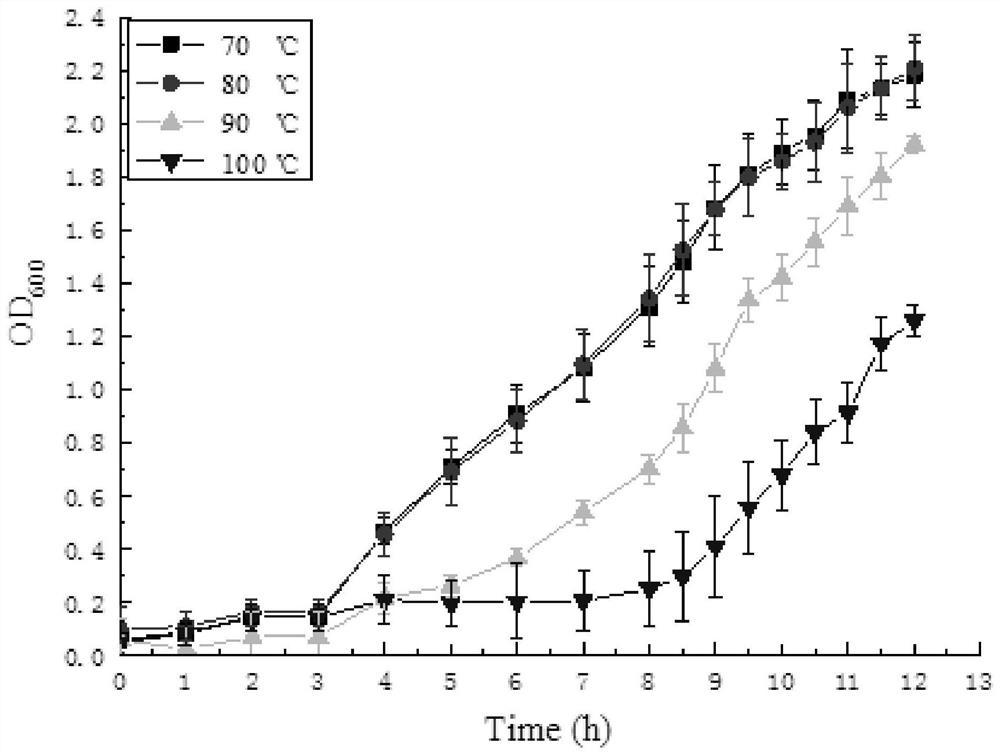An extreme thermophilic bacterium and its application in high temperature composting fermentation
A thermophilic and bacterial technology, which is applied in the field of microbial technology and environmental engineering, can solve the problems of difficulty in reaching higher fermentation temperature and shortage, and achieve the effects of accelerating putrefaction, saving time and cost, and broad substrate spectrum
- Summary
- Abstract
- Description
- Claims
- Application Information
AI Technical Summary
Problems solved by technology
Method used
Image
Examples
Embodiment 1
[0056] Embodiment 1: Food waste composting treatment
[0057] Take 5 tons of food waste, cut and stir to make it into pieces with a diameter of about 3cm. Put the pieces into the fermentation device, add 3% quicklime, 0.5g esterase, 0.8g cellulase, 0.4g alkaline amylase, 0.5g alkaline protease, control the moisture content of the material at about 80%, and stir evenly Then stand still for 0.5h. Then put 1.5 tons of GW-2 bacterial agent into the fermenter (when making, the volume ratio of fermentation broth to dry wood chips is 1:0.9), stir evenly and start heating. After 0.5h, the temperature in the fermenter reaches 45°C. After maintaining the heating for 3 hours, the temperature rises to 60°C, the heating is stopped, and the high-temperature composting stage is entered at this time. After 20 hours, the temperature rose to 100°C and the humidity dropped to 75%. After 24 hours, the temperature in the fermenter began to decrease slowly, and dropped to 60°C after 44 hours. At...
Embodiment 2
[0058] Example 2: Farming solid waste composting
[0059] Take 10 tons of pig farm feces, put in 4.5% quicklime, stir evenly, control the moisture content of the material at 82%, put in 0.8g esterase, 1.3g cellulase, 0.3g alkaline amylase, 0.8g alkaline protease and continue Mix and stir, turn on the electric heating to raise the temperature to 45°C and maintain it for 1h. Put in 4 tons of GW-2 bacterial agent sawdust, (during production, the volume ratio of fermentation liquid to dry sawdust is 1:0.8), stir well, increase the electric heating power to raise the temperature to 45°C, and start high-temperature composting. After 4 hours of start-up, the temperature of the compost heap rose to 65°C, and gradually increased within 24 hours of start-up, and finally reached 85-100°C, and the humidity gradually decreased from the initial 80% to about 53%. Then the temperature dropped slowly, and the temperature dropped to 65°C within 48 hours of starting. At this time, 20% of the vo...
Embodiment 3
[0060] Example 3: Fertilizer composting of agricultural by-products
[0061] Take 5 tons of straw, add it to the fermentation device with cutting and stirring, and continuously cut and stir it into pieces of about 6cm, put in 5% quicklime, stir evenly, control the moisture content of the material at 85%, put in 0.7g esterase, 1.3g cellulase , 0.6g alkaline amylase, and 0.5g alkaline protease continued to mix and stir, and turned on the electric heating to raise the temperature to 45°C and maintain it for 2h. Put in 2.5 tons of GW-2 bacterial agent sawdust, (during production, the volume ratio of fermentation liquid to dry sawdust is 1:1), stir well, increase the electric heating power to raise the temperature to 45°C, and start high-temperature composting. After 4 hours of start-up, the temperature of the compost heap rose to 60°C, and gradually increased within 24 hours of start-up, and finally reached 85-100°C, and the humidity gradually decreased from the initial 87% to abo...
PUM
| Property | Measurement | Unit |
|---|---|---|
| radius | aaaaa | aaaaa |
| diameter | aaaaa | aaaaa |
Abstract
Description
Claims
Application Information
 Login to View More
Login to View More - R&D
- Intellectual Property
- Life Sciences
- Materials
- Tech Scout
- Unparalleled Data Quality
- Higher Quality Content
- 60% Fewer Hallucinations
Browse by: Latest US Patents, China's latest patents, Technical Efficacy Thesaurus, Application Domain, Technology Topic, Popular Technical Reports.
© 2025 PatSnap. All rights reserved.Legal|Privacy policy|Modern Slavery Act Transparency Statement|Sitemap|About US| Contact US: help@patsnap.com

